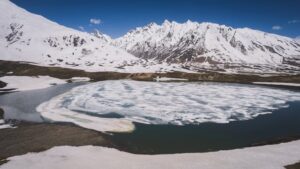Physical Address
23,24,25 & 26, 2nd Floor, Software Technology Park India, Opp: Garware Stadium,MIDC, Chikalthana, Aurangabad, Maharashtra – 431001 India
Physical Address
23,24,25 & 26, 2nd Floor, Software Technology Park India, Opp: Garware Stadium,MIDC, Chikalthana, Aurangabad, Maharashtra – 431001 India

The effects of climate change in the Himalayan region are becoming increasingly clear and potentially catastrophic. Among these, the rapid expansion of glacial lakes due to accelerated glacial melting is emerging as a prominent concern. According to a recent report by India’s Central Water Commission (CWC), glacial lakes and other water bodies in the Himalayas have expanded their surface area by 10.81% from 2011 to 2024. In India alone, the expansion rate has been more significant, with a 33.7% increase in the area of glacial lakes over the same period. This trend signals a heightened risk of glacial lake outburst floods (GLOFs), an alarming hazard for downstream communities, infrastructure, and biodiversity.
The Growing Threat of Glacial Lake Outburst Floods (GLOFs)
As the CWC report outlines, the expansion of glacial lakes is primarily driven by the warming climate, which accelerates the melting of Himalayan glaciers. The physical manifestation of climate warming in this region is increasingly visible through shrinking glaciers and expanding lakes. These changes are not only reshaping the landscape but are also raising the risk of catastrophic flooding events. Glacial lakes often form behind natural moraine dams, which are unstable and vulnerable to sudden breaches. When these dams fail, vast volumes of water are released downstream, resulting in GLOFs that can devastate communities and ecosystems along their path.
GLOFs are particularly dangerous because they occur without warning, leaving little time for evacuation. When a lake’s natural moraine dam is breached, the sudden release of water can be catastrophic, sweeping away villages, destroying infrastructure, and causing widespread environmental damage. With increasing temperatures, the frequency of such events is also expected to rise, posing a direct threat to communities and critical infrastructure in high-altitude regions.
Key Findings of the CWC Report
The CWC’s report reveals several critical trends regarding the expansion of glacial lakes in the Indian Himalayas. Between 2011 and 2024, the area of glacial lakes in India expanded from 1,962 hectares to 2,623 hectares, a significant increase of 33.7%. Across the broader Himalayan region, including neighboring countries such as Bhutan, Nepal, and China, the total lake area grew by 10.81%, from 533,401 hectares in 2011 to 591,108 hectares in 2024.
The CWC has identified 67 lakes in India that experienced over a 40% increase in surface area, placing them in the high-risk category for GLOFs. The regions with the most notable expansions include Ladakh, Himachal Pradesh, Uttarakhand, Sikkim, and Arunachal Pradesh. This rapid growth underscores the urgent need for intensified monitoring and disaster preparedness in these areas, as the risk to both people and the environment continues to escalate.
The Role of Advanced Monitoring Technologies
Monitoring glacial lakes in the remote, rugged terrain of the Himalayas poses substantial challenges. To overcome these obstacles, the CWC has adopted advanced satellite technology, including the Sentinel-1 Synthetic Aperture Radar (SAR) and Sentinel-2 multispectral imagery. These tools allow for precise, all-weather monitoring of lake size with an accuracy of up to 10 meters, even in challenging conditions like cloud cover.
These high-resolution capabilities are essential for tracking changes in lake size and providing timely updates on high-risk lakes. The CWC’s use of satellite data facilitates early detection of lake expansion, enabling authorities to take preventive measures and issue timely warnings to vulnerable communities. By reducing monitoring intervals and improving data precision, the CWC aims to establish a robust system for early detection and response to the challenges posed by the expanding Himalayan glacial lakes.
Regional and Transboundary Risks
The Himalayan region’s interconnected river systems highlight the transboundary nature of GLOF risks. Rivers originating in the Himalayas, such as the Ganga, Brahmaputra, and Indus, provide water to millions of people across India, Bhutan, Nepal, and Bangladesh. When a glacial lake breaches in one country, the floodwaters can have severe impacts downstream in neighboring countries. For this reason, managing GLOF risks requires close cooperation and data-sharing among countries in the region.
The CWC’s report underscores the importance of joint monitoring efforts and collaborative risk assessments. By sharing information on lake expansion and implementing coordinated disaster management strategies, countries can improve their ability to mitigate the impacts of GLOFs. Transboundary cooperation is also vital for developing early warning systems, enhancing preparedness, and ensuring effective response measures in the event of a GLOF.
Implications for Communities and Ecosystems
The potential impacts of GLOFs extend beyond immediate flood risks. As glacial lakes expand, they alter the dynamics of the Himalayan water systems, which play a crucial role in sustaining communities and ecosystems downstream. The increased water spread area in these lakes influences water availability in major river systems, potentially affecting agriculture, drinking water supplies, and hydropower generation. With regional populations dependent on these rivers for their livelihoods, the changes induced by glacial lake expansion could have far-reaching socioeconomic and environmental consequences.
Furthermore, GLOFs pose a severe threat to biodiversity in the Himalayan region, which hosts unique flora and fauna adapted to the cold mountain environment. Flooding can disrupt habitats, alter vegetation patterns, and create conditions that threaten native species. In some cases, the release of water from glacial lakes can cause landslides, further destabilizing the ecosystem and accelerating soil erosion.
References:
https://cwc.gov.in/glacial-lakeswater-bodies-himalayan-region
Glacial Lake Outburst Floods (GLOFs)
References:
Banner Image : Photo by Vikash Singh https://www.pexels.com/photo/pensi-la-also-known-as-penzi-la-mountain-pass-4-400-m-between-suru-valley-and-zanskar-valley-ladakh-region-india-17851146/
Photo by Vikash Singh https://www.pexels.com/photo/pensi-la-also-known-as-penzi-la-mountain-pass-4-400-m-between-suru-valley-and-zanskar-valley-ladakh-region-india-17851168/